We all adore our furry companions and want the best for them. But as we all know, keeping them safe and healthy is more than just regular walks and a good scratch behind the ears. It involves knowing what’s good and what’s bad for their diet too. And that’s why we’ve got a scrumptious topic to discuss today – caramel. It’s sweet, it’s sticky, and it’s a common ingredient in so many of our favorite treats. But can dogs have caramel? The short answer is no, dogs should not have caramel.
As you’re unwrapping that caramel candy or slicing a piece of caramel-drizzled cake, your pooch might be looking at you with those irresistible, pleading eyes. Should you give in and let them have a taste? Or could that bite lead to health issues?
In this blog post, we’ll dive deep into the world of caramel and dogs. We’ll discuss what caramel is, the possible health effects it might have on your canine companion, and how to handle situations where your dog might have snuck a bite. Read on to ensure that you’re informed, prepared, and able to give your furry friend the best care possible!
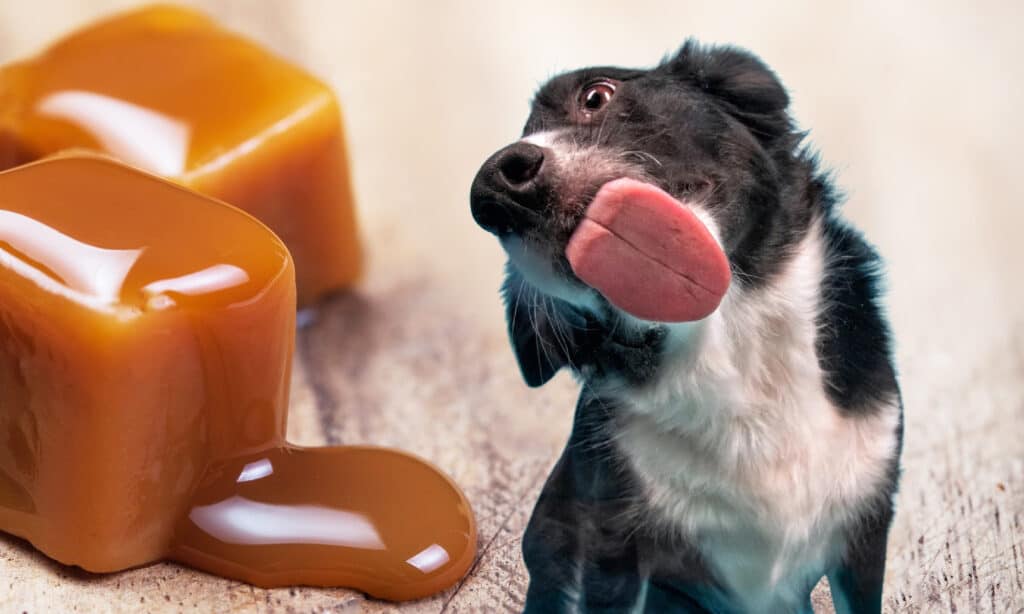
What is Caramel?
Caramel, that delightful, gooey substance that makes our desserts even more irresistible, is a confectionery product made by heating various types of sugars. It can range in color from golden to deep brown, depending on how long it’s been heated. The process of making caramel is known as caramelization, where sugar is slowly heated to around 170°C (340°F). This results in sugar molecules breaking down and forming a complex mixture of compounds, giving caramel its unique flavor and color.
Typically, caramel is made up of sugar, water, and sometimes a bit of salt or vanilla for extra flavor. Commercially produced caramels may also contain milk or cream, making them softer and chewier. You’ll find caramel in a variety of treats, from candies and chocolates to sauces and flans. It’s a versatile ingredient loved for its rich, sweet, and slightly buttery taste.
However, as we all know, just because something is delicious to us humans, doesn’t mean it’s good for our four-legged friends. So, before you succumb to your pup’s pleading eyes, it’s important to understand the impact caramel might have on their health. Let’s delve into that next.
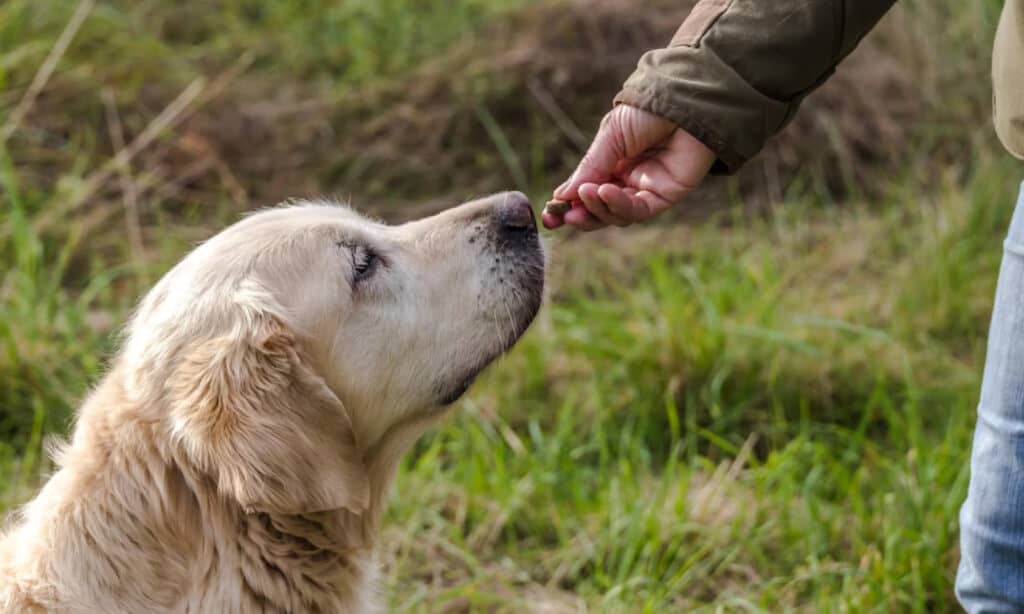
The Canine Diet: What’s Healthy?
Dogs, being the loyal companions that they are, often seem to be interested in whatever we’re eating. But it’s crucial to remember that dogs’ dietary needs and digestive systems are very different from ours. So, what exactly constitutes a healthy diet for a dog?
First and foremost, dogs are primarily carnivorous but can be considered omnivores in a dietary sense. This means their diet should be rich in animal protein sources like meat, poultry, and fish. But it’s not all about the meat. Dogs also need a balanced intake of vegetables, fruits, and grains for essential vitamins, minerals, and fiber.
In terms of nutrients, a dog’s diet should be high in protein, followed by a balanced amount of fats, and a small portion of carbohydrates. Essential nutrients like vitamins A, B, D, E, and K, as well as minerals like calcium, potassium, and iron, play vital roles in a dog’s overall health and well-being.
It’s important to note that while dogs can consume some fruits and vegetables, not all are safe for them. Foods like grapes, raisins, onions, garlic, chocolate, and anything containing caffeine or alcohol are toxic to dogs and should be avoided.
Commercial dog foods are typically formulated to meet these dietary needs. They come in various forms – kibble, canned, raw, and dehydrated. Feeding your dog high-quality, vet-approved dog food is usually the easiest way to ensure they’re getting the balanced nutrition they need.
Treats are also part of a dog’s diet, but they should not make up more than 10% of a dog’s daily calorie intake. Treats are often used for training purposes and as a way to show affection. However, it’s essential to choose dog-friendly treats that are safe and healthy.
With all this in mind, it’s clear that the question of whether dogs can have caramel is not just about whether they’ll enjoy it (they probably will!), but whether it’s good for their health. So, let’s dig deeper into this sweet conundrum.

Can Dogs Have Caramel
The short answer is: it’s best to avoid feeding your dog caramel. Although small amounts of caramel aren’t likely to be toxic to dogs, it’s not a healthy treat option for them. There are several reasons why caramel is not suitable for our furry friends.
Firstly, caramel is high in sugar. Dogs do not need added sugars in their diet. Unlike humans, dogs can get all the energy they need from a balanced diet of proteins, fats, and complex carbohydrates. Consuming excess sugar can lead to obesity and other health problems in dogs, such as diabetes and dental issues.
Secondly, some ingredients often found alongside caramel in various foods can be harmful, or even deadly, to dogs. For instance, chocolate and certain artificial sweeteners like xylitol, often found in candies, are toxic to dogs. So, a caramel-flavored treat that’s safe for humans might be dangerous for your pup.
Lastly, caramel, especially when consumed in large amounts, can lead to gastrointestinal issues in dogs. The high sugar and fat content can cause upset stomach, vomiting, and diarrhea.
So, while your dog might find the smell of caramel tantalizing and might gobble it up if given the chance, it’s better to resist those puppy dog eyes. Remember, as pet parents, our job is to ensure our furry friends stay healthy and happy. Stick to dog-friendly treats, and you can’t go wrong.

Why Caramel Can Be Harmful to Dogs
While those puppy dog eyes can be hard to resist, it’s essential to understand why caramel can be harmful to dogs. Let’s delve into the reasons a little deeper.
- High Sugar Content: Caramel is made primarily from sugar, and it’s no secret that too much sugar is bad for anyone’s health, including our dogs. Unlike humans, dogs don’t need added sugars in their diet. Their bodies are designed to get all the necessary energy from proteins, fats, and some complex carbohydrates. Consuming excess sugar can lead to several health problems in dogs, including obesity, diabetes, and dental issues like tooth decay and gum disease.
- Digestive Issues: Caramel, especially when consumed in large amounts, can cause gastrointestinal problems in dogs. This is due to its high sugar and fat content. Your dog might experience symptoms like an upset stomach, vomiting, and diarrhea after eating caramel.
- Potential Presence of Toxic Substances: While caramel itself isn’t toxic to dogs, it’s often found in foods that contain ingredients which are harmful to dogs. For example, chocolate, a common partner to caramel, is toxic to dogs. Similarly, many sugar-free or reduced sugar foods and candies use artificial sweeteners like xylitol, which is extremely dangerous for dogs, even in small amounts.
- Risk of Choking or Blockages: This might not apply to all types of caramel, but some candies or treats, like caramel apples or hard caramel candies, can pose a choking hazard or cause blockages in the digestive system, especially in small breed dogs.
The key takeaway is that while a tiny lick of caramel might not immediately harm your dog, regularly allowing them to consume caramel or foods containing caramel can lead to serious health issues over time. It’s always better to err on the side of caution and keep your pup’s diet healthy, balanced, and dog-friendly.
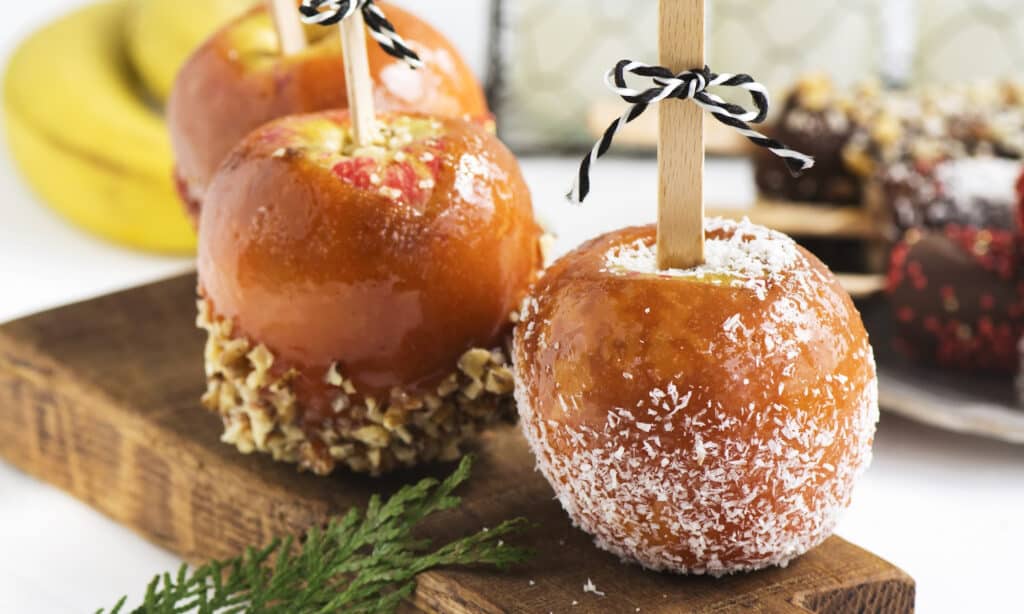
Symptoms of Caramel Ingestion in Dogs
Despite our best efforts, sometimes our dogs manage to get into foods they shouldn’t. If your dog has snuck some caramel, it’s important to know the potential symptoms that may arise.
The symptoms your dog might experience can vary widely based on the amount of caramel they’ve consumed, the presence of any additional harmful ingredients, and your dog’s size, age, and overall health condition. Here are some signs to watch for:
- Upset Stomach: One of the most common symptoms of caramel ingestion in dogs is an upset stomach. This could manifest as restlessness, discomfort, and decreased appetite.
- Vomiting and Diarrhea: If your dog’s system is trying to get rid of something it doesn’t agree with, you might notice vomiting or diarrhea. If these symptoms persist, it’s important to contact your vet immediately.
- Increased Thirst and Urination: High sugar content can cause an increase in thirst and urination. If you notice your dog drinking and urinating more than usual, it could be a sign that they’ve eaten something high in sugar like caramel.
- Hyperactivity: Excess sugar can also lead to temporary hyperactivity. If your dog is more excitable, restless, or energetic than usual, they might have consumed a high-sugar food.
- Lethargy: On the other hand, if your dog consumed caramel with toxic substances such as chocolate or xylitol, they might show signs of lethargy or weakness, and this requires immediate veterinary attention.
- Other Serious Symptoms: In the worst-case scenario, if the caramel contained a toxic ingredient like xylitol, more severe symptoms like difficulty walking or standing, seizures, and even loss of consciousness could occur. These are emergency signs, and you should seek veterinary help immediately.
Remember, these symptoms may not appear immediately and could develop several hours after ingestion. If your dog has eaten caramel and is showing any of these signs, or if you’re simply worried, it’s always a good idea to call your vet for advice. Prevention is always the best approach, but knowing the signs of trouble can make all the difference if your pup manages to sneak a sweet treat.
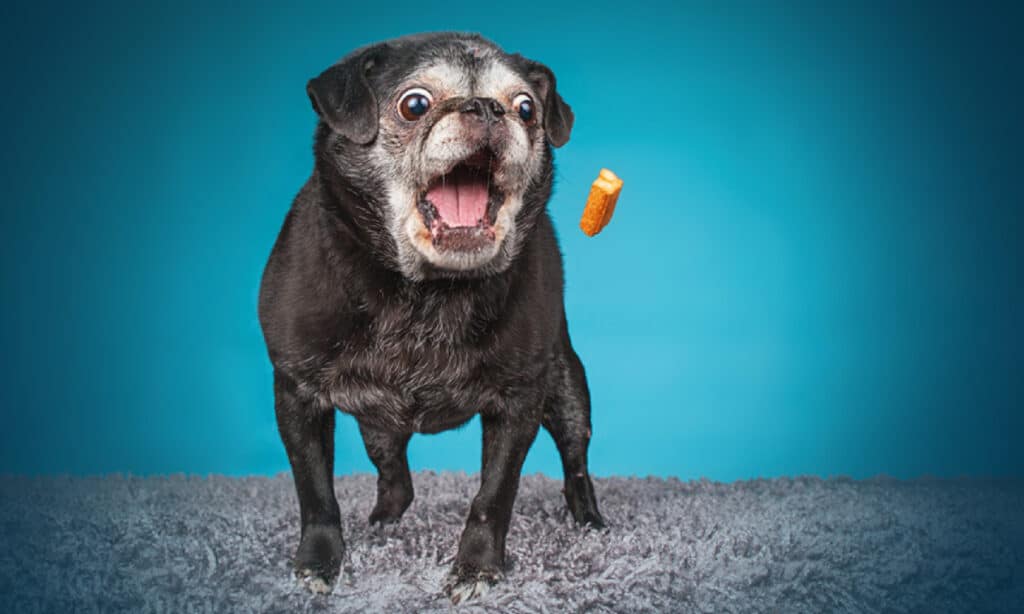
The Role of Vets in Handling Caramel Ingestion
If you suspect your dog has eaten caramel, especially in large quantities or if it contained other harmful ingredients like chocolate or xylitol, it’s crucial to contact your veterinarian immediately. Let’s take a look at the role of vets in handling caramel ingestion in dogs.
- Assessing the Situation: Upon reaching out to your vet, they’ll likely ask questions about your dog’s size, the amount of caramel consumed, and any symptoms your dog may be displaying. This will help them assess the severity of the situation and guide you on the next best steps.
- Treatment Plan: Depending on the situation, your vet might suggest monitoring your dog at home for any developing symptoms or advise you to bring your dog in for a check-up. In severe cases, immediate veterinary attention will be necessary.
- Inducing Vomiting: In some instances, if your dog consumed the caramel recently, your vet might instruct you on how to induce vomiting at home, or they may do this at the clinic. This can help get rid of the harmful substance before it’s fully digested. However, you should never try to induce vomiting without the guidance of a vet.
- Providing Supportive Care: If your dog has consumed a toxic ingredient, your vet might provide supportive care such as intravenous fluids, and medications to control symptoms, and in severe cases, hospitalization might be required.
- Follow-up Checks: Your vet might also schedule follow-up appointments to monitor your dog’s recovery and ensure there are no long-term effects from caramel ingestion.
- Preventive Advice: Your vet can provide advice on how to prevent such incidents in the future and educate you about safe treat alternatives for your dog.
Remember, your vet is your best resource when it comes to your dog’s health. Don’t hesitate to reach out if you’re worried. It’s always better to be safe than sorry when it comes to the health and well-being of our furry friends.
Preventive Measures: Keeping Caramel Away from Dogs
The best way to keep our furry friends safe from the potential harm caused by caramel is prevention. Here are some steps you can take to ensure caramel and other potentially harmful foods stay out of your dog’s reach:
- Safe Storage: Keep caramel and foods containing caramel safely stored away. This might mean placing them in high cupboards or using child-proof containers that your dog can’t open. Remember, dogs can be crafty, so it’s better to be safe than sorry.
- Education: Make sure everyone in your household knows about the dangers of feeding caramel to dogs. This includes children, who might be tempted to share their sweet treats with their furry friends.
- Trash Security: Dogs often find a way into the trash can, where they might find discarded caramel wrappers or food. Ensure your trash can is securely closed or stored in a place your dog can’t access.
- Training: Train your dog to understand the command “leave it.” This can be a lifesaver, especially when your dog is about to pick up something harmful off the ground.
- Use Dog-Safe Treats: To curb your dog’s sweet tooth, use dog-safe treats instead. There are plenty of dog-friendly treats available that can satisfy their craving for something tasty without the harmful effects.
- Supervision: Keep an eye on your dog during walks or when they’re exploring new environments. Dogs are naturally curious and might pick up something harmful when unattended.
Remember, prevention is always the best cure. By taking these steps, you’ll be helping to keep your dog safe, healthy, and happy. Dogs trust us to look out for them, and that includes keeping them safe from foods that could harm them.

Alternatives to feeding dogs caramel
List of Safe and Healthy Treats for Dogs
If you’re looking for some safe and healthy alternatives to caramel, fear not! There are plenty of treats out there that your furry friend will love just as much. Here are a few options:
- Carrots – Not only are they low in calories, but also high in fiber and vitamins. Plus, they’re great for keeping your pup’s teeth clean.
- Apples – Apples are another great option for a low-calorie snack that is also high in fiber and vitamins.
- Peanut Butter – As long as it doesn’t contain xylitol (a sugar substitute that is toxic to dogs), peanut butter can be a tasty treat filled with protein and healthy fats.
- Blueberries – These little guys are packed with antioxidants, vitamins, and fiber.
- Green Beans – Dogs love the crunchiness of green beans, which are also low in calories and high in vitamins.
Homemade Dog Treat Recipes Without Using Caramel
Another way to make sure your dog is getting safe treats is by making them yourself! Here are some easy homemade dog treat recipes that don’t use caramel:
Peanut Butter Banana Bites
- Mash up one ripe banana with 1/4 cup of creamy peanut butter until smooth.
- Spoon the mixture into silicone molds or onto a baking sheet lined with parchment paper, then freeze until firm.
Carrot Oatmeal Cookies
- 1 cup of rolled oats
- 1/2 cup of grated carrot,
- 1/4 cup of unsweetened applesauce
- 1 egg together until combined.
Mix ingredients together. Drop onto a baking sheet lined with parchment paper and bake at 350°F for 20-25 minutes or until golden brown.
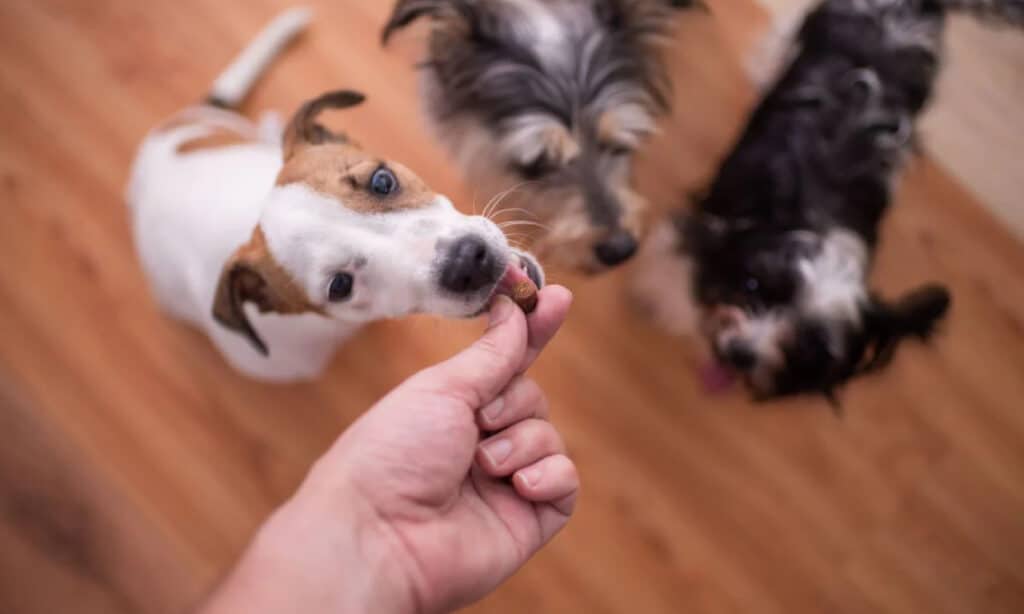
Blueberry Yogurt Bites
- 1 cup of plain non-fat Greek yogurt 1
- 1/2 cup of fresh blueberries
Mix ingredients together. Spoon the mixture into silicone molds or onto a baking sheet lined with parchment paper, then freeze until firm.
Sweet Potato Chews
- Slice a sweet potato into thin rounds and bake at 250°F for 3 hours or until crispy.
These make great long-lasting chews that dogs love!
Chicken Jerky
- Cut boneless, skinless chicken breasts into thin strips and bake at 200°F for several hours or until fully dried out.
This is a high-protein treat that dogs go crazy for. So next time you’re tempted to give your pup some caramel, consider one of these safe and healthy alternatives instead!
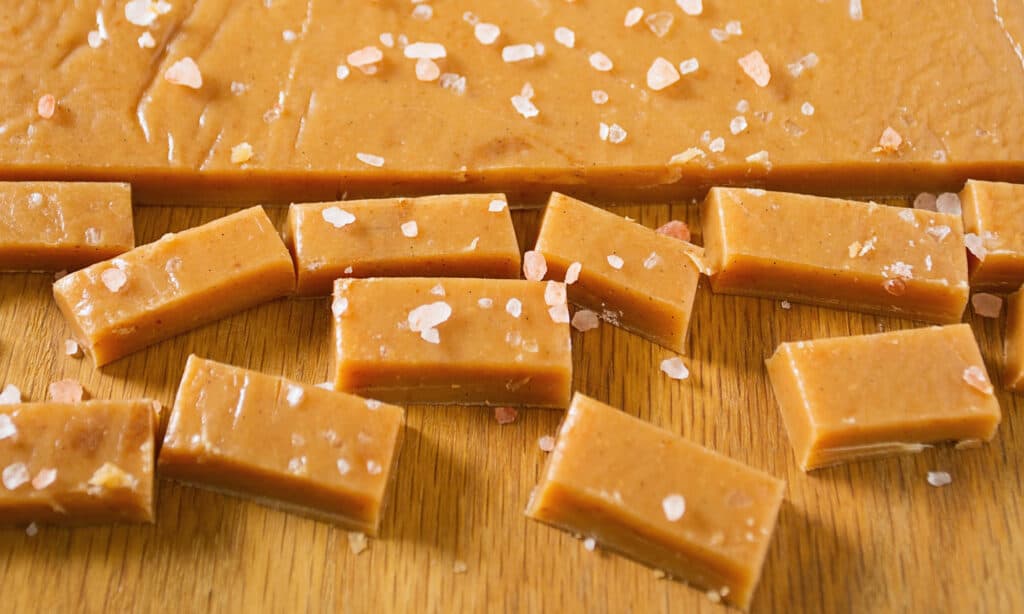
Conclusion
In conclusion, while we love to spoil our furry friends, it’s important to remember that not all human treats are safe for dogs. Caramel, with its high sugar content and potential presence of other harmful ingredients, is one such treat that’s best kept out of reach of our four-legged companions.
It can be tough to resist those pleading eyes as we enjoy our sweet treats, but as responsible pet parents, our primary concern should always be the health and well-being of our dogs. Feeding your dog a balanced, nutritious diet and dog-safe treats is the best way to keep them healthy and satisfied.
If your dog does manage to sneak some caramel, remember not to panic. Keep an eye out for any symptoms of discomfort, and don’t hesitate to reach out to your vet if you’re worried.
In the end, our dogs depend on us to make the right decisions for their health. By keeping caramel off their menu, we’re doing just that.
Thank you for joining us in exploring this topic. Keep following our blog for more insights into your dog’s health, nutrition, and overall well-being. Here’s to many happy, healthy years with your canine companion!
~Lindsie
